How to process gladiolus bulbs before planting?
It is quite easy to grow large, healthy, pleasing beauty gladioli - but! Even healthy planting material needs a number of health measures before planting. Why, how and how to process gladioli bulbs before planting, we will tell you right now.
Why do I need pre-planting treatment?
Indeed, why, if, before storing the tubers of gladioli, they had already been disinfected, stored under proper conditions, under the vigilant control of a caring summer resident. But the regal flower, unfortunately, has a low immunity to diseases and pests, therefore it needs the help of a gardener.
First of all, you need to remember that flower pathogens are ubiquitous. And if during storage the diseases did not appear, this does not mean the absence of spores of fungi, viruses and pathogenic bacteria on the bulbs. In order to deprive the viability of pathogenic microorganisms, they are treated with appropriate preparations.
The second reason is the extermination of the eggs of insect pests preserved on the scales of the tubers, and the creation of a kind of shell that protects against the enemies present in the soil.
The third argument in favor of spring processing is that the planting material needs time to fully adapt to the flowerbed, to grow roots. With a short summer, typical for most regions of Russia, such a waste of time is a luxury, so the planting material is treated with means to accelerate growth.
Having taken out the planting material after winter storage, it is immediately examined and dysfunctional bulbs are discarded - with obvious signs of disease, weeping extensive spots, dried out, rotting.
Processing time
Preparation of planting material begins 2-3 weeks before the planned landing date. Specific terms are determined based on the climatic conditions of the region:
- in the south of Russia - from the end of March;
- in the middle zone - from the first ten days of April;
- in Siberia, the Urals and the North-West - from the second decade of April.
All pre-planting preparation of bulbs consists of three stages: cleaning, germination and processing of planting material.
With a large number of bulbs, different varieties are soaked in separate containers, since not all varieties are equally resistant to various diseases.
Treatment of bulbs from diseases
For treatment against diseases - fungal, viral, bacterial - solutions are used that are popular among gardeners.
- "Maxim" - an antifungal drug, available in a ready-to-use form. Processing time - 1-2 hours.
- Fundazol - a remedy against fusarium, powdery mildew, rot, spotting. 10 g of powder is dissolved in 2 l of water, soaked for 2 hours.
- Bordeaux liquid counteracts most of the known fungal diseases. The bulbs are kept in a 1% solution for 1.5-2 hours.
- Copper oxychloride helps to avoid infection with late blight, scab, rust. The solution is prepared at the rate of 4 g of the drug per 1 liter of water. The corms are soaked for 3-4 hours.
- Potassium permanganate - a familiar remedy that works against a huge number of pathogens. It is believed that its effectiveness is low, however, soaking with a 2% solution (2 g of a substance dissolved in 1 liter of water) gives a guaranteed result. Processing time is 30-40 minutes.
Before processing, old dry scales are removed, which hinder the penetration of solutions to the body of the tuber.
Insecticide treatment
The following drugs will be used to protect the bulbs from pests.
- "Aktara" - the solution is prepared from one package containing 1.4 g of the substance and 10 liters of water. The insecticide is effective against leaf-gnawing and sap-sucking pests that live in the ground in early spring. The processing time is 30 minutes. The drug also has a fungicidal effect.
- "Malathion" ("Karbofos", "Fufanon") protects against aphids, spider mites, weevils, sawflies. The soaking solution is prepared from 1 ampoule of the agent and 5 liters of water, the tubers are soaked for 30 minutes. They work with the drug carefully, it is toxic to humans.
- "Confidor" affects sucking insects, various types of moths, moths. 3 g of the drug is diluted in 10 liters of water, the processing time is 30 minutes.
The bulbs affected by thrips during winter storage are first placed in a tight plastic bag, put a cotton swab moistened with alcohol there, tied tightly and left for 2-3 days. The rest of the processing steps are carried out after the destruction of insects.
To protect gladioli from thrips after disembarkation, Fitoverma solution is poured into the ground during planting. It can also be used to soak bulbs.
Treatment with "Dichlorvos" is often practiced: the bulbs are placed in a bag, sprayed with an insecticide, and tied tightly. After 30 minutes, the treatment is considered completely complete.
Stimulating the development of gladioli
To speed up survival in the ground, plant growth and the rapid formation of a large number of peduncles, corms are treated with trace elements:
- Mikromix;
- "Quotes".
The preparations contain a complex of basic nutrients (nitrogen, phosphorus, potassium) and trace elements. The rules for the preparation of solutions and instructions for use are given in the instructions.
After microelements, the bulbs are treated with stimulant agents familiar to growers:
- "Kornevin", which stimulates the emergence and development of roots;
- "Epin", activating growth, increasing stress resistance of plants, their immunity, increasing the duration of flowering (use a solution of 2.5 g of the product in 5 liters of water for 8-10 hours);
- "Kornerostom", "Heteroauxin" - powerful stimulants of the development of the root system;
- "Zircon" - a complex of microelements that accelerates the development of flowers;
- humates, for example 0.2% sodium humate solution, which has a general positive effect on development, growth and flowering.
The corms are kept in a stimulant solution prepared according to the instructions for 30 minutes to 3 hours. To save time, they combine pest control with stimulation.
Simultaneous processing of the gladiolus planting material with microelements and stimulants is allowed. It is useful to acidify the water for preparing such a solution with citric or succinic acid.
All processing methods are also suitable for baby bulbs, but the concentration of each type of solution in this case should be 2 times less.
We save rotten corms
It is pointless to plant rotten bulbs, but if the affected area is small, and the bottom is not damaged, you can try to save the planting material:
- with a sharp disinfected tool, cut out the affected part to healthy scales;
- the sections are treated with brilliant green, cinnamon (powder), activated or crushed charcoal;
- leave to dry.
It is better to plant such bulbs separately from the rest with preliminary treatment of the soil with fungicides to prevent the spread of the disease.
Moldy bulbs - what to do?
The appearance of mold is a sign of a violation of storage conditions (fluctuations in temperature, humidity, insufficient air exchange). If the lesion manifests itself during storage, the bulbs are treated with 10% potassium permanganate, dried and removed again. If mold is found during preparation for planting, the affected scales are carefully removed and then all the necessary pre-planting processing is carried out.
Resuscitation of dried bulbs
With insufficient humidity in the storage room, tubers often dry out. For rescue use solutions of 5% hydrogen peroxide (1 tablespoon per liter of water), soda (1 teaspoon per liter) or "Epin". The duration of the water procedure is 30 minutes.
The bulbs require drying after each wet treatment.
Experienced tips
Experienced summer residents who have been cultivating gladioli on their plots for many years often replace chemical preparations with home remedies that give no less effect.
- Applique bulbs with boiling water. Helps get rid of pathogenic microflora, eggs and pest larvae. For beginners, it is better to carry out the procedure under the supervision of an experienced mentor, since there is a high probability of damage to small roots and sprouts that have hatched.
- Hydrogen peroxide completely frees tubers from pathogens. For every 100 ml of water, take 10 ml of a 5% agent, put onions in the solution. Ideally connect an aquarium compressor. After 6-12 hours, the planting material is completely disinfected. This method is especially useful for treating children.
- Soaking with garlic infusion replaces treatment against diseases and pests, especially thrips. For a liter of water, take 100 g of garlic juice, mix, leave in the onion solution for 2-3 hours.
- Warming up with water for 24 hours at a temperature of 45-50 ° C replaces soaking in stimulants and treatment with fungicides. If you cook barley malt instead of water, the bulbs will receive an additional dose of disinfection. It is advisable to use an aquarium compressor during the procedure to ensure the circulation of the liquid. After heating, the tubers are rinsed with cold water and dried.
- Ash infusion for soaking (2 tablespoons per liter of water) disinfects tubers per day, kills some pests, and stimulates growth.
- Disinfection with table salt: 2 tbsp. l. with a slide, dissolve in a liter of water, put the onions for 5-7 minutes.
- On problem garden areas, the bulbs additionally immediately before planting 20-30 minutes. kept in a strong solution of potassium permanganate (2.5 g / l), do not rinse.
And finally, here are some tips from florists who have dedicated themselves to growing collection gladioli.
- Using "Fitoverma" for processing "kills two birds with one stone": the bulbs are disinfected, insect pests die. Pests and pathogens do not develop immunity to it, which cannot be said about chemicals.
- Unhealthy bulbs rarely produce full flower stalks. The situation will be corrected by soaking such a material with a solution of thio-urea (thio-carbamide). For a liter of water, take 2-2.5 g of the product, incubate in the solution for 20-25 minutes.
- During storage, naphthalene helps to get rid of thrips, which is poured into storage boxes. The measure exempts from the spring treatment of planting material with insecticides. The same effect is produced by the cloves of garlic spread between the tubers.
- Warm (30-35 ° C) solutions are more effective.
Beginners attribute the failures of growing regal flowers to their capriciousness. Practice shows that the correct preparation of planting material minimizes the care of gladioli, while observing the other rules of planting and growing.
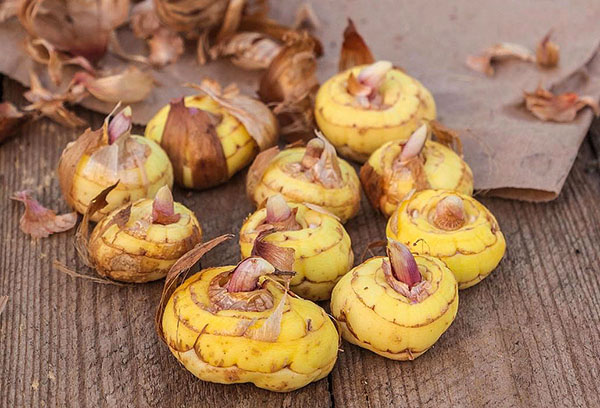
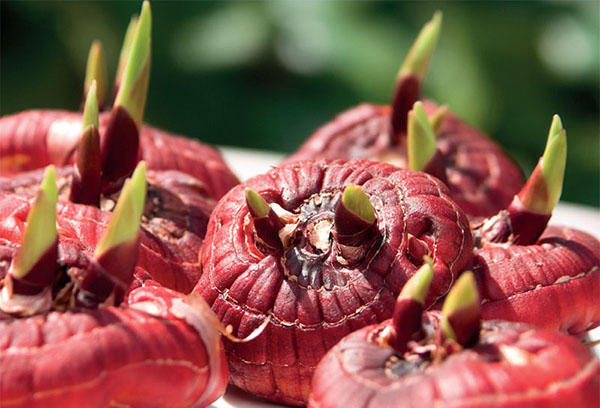

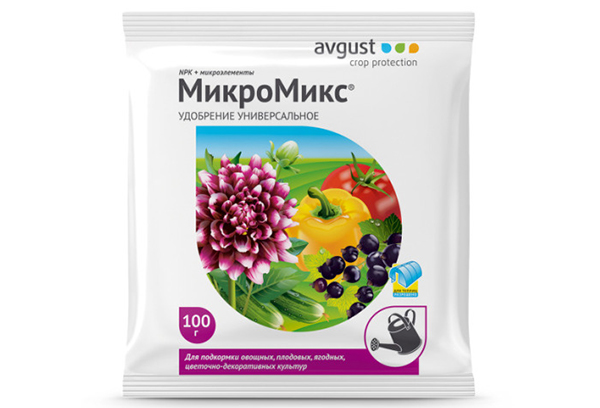
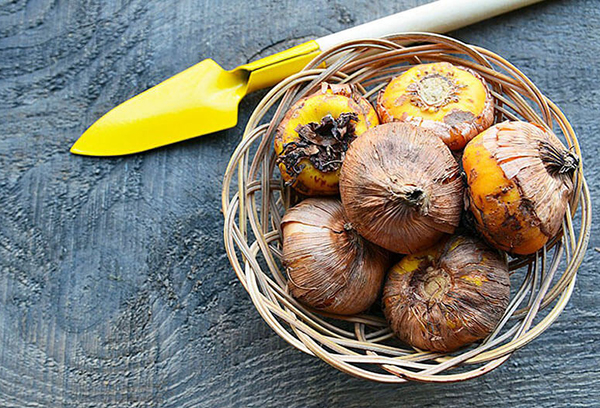
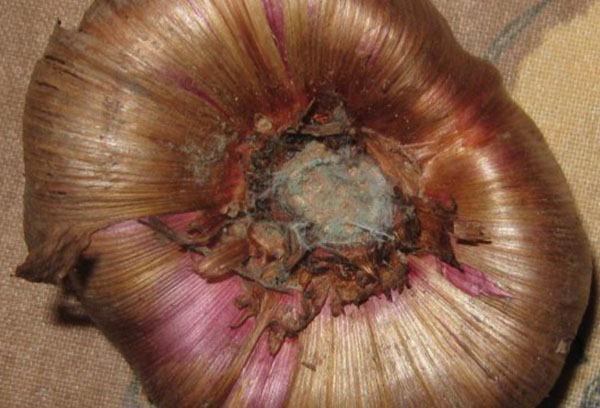
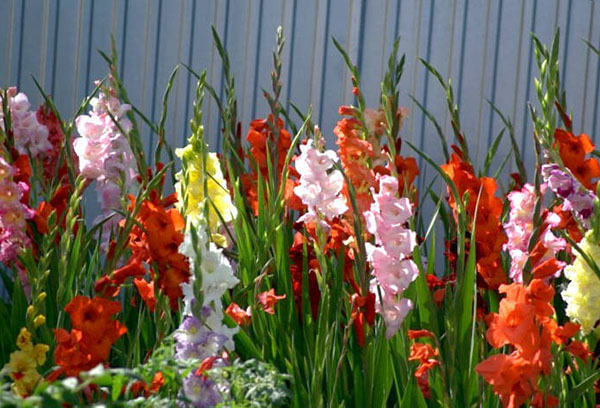



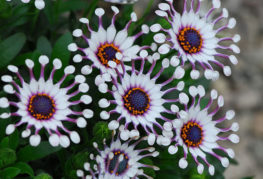

and will be published shortly.